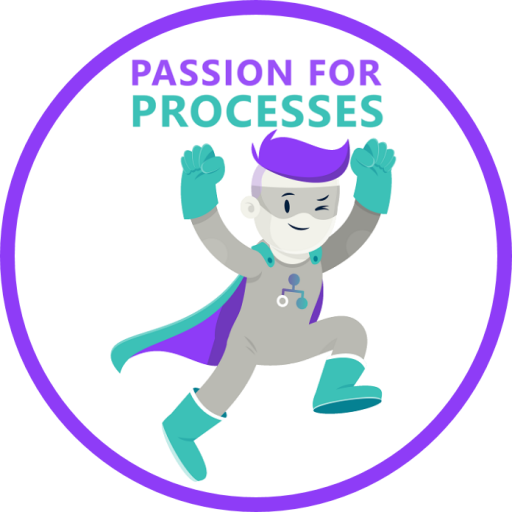
Hi,
I have tried to export EPC to BPMN in Aris Architech & Designer, there is an organizational element in the EPC diagram, but when I transform it to BPMN, the element is loss.I have seen the video at this URL https://www.ariscommunity.com/videos/learn-how-epc-models-can-be-transformed-bpmn-models,
In the video, the tool can produce swimlanes which are representations of organizational elements.
Is there something wrong with my experiment so that it doesn't produce swimlane?
For more information, please see attached picture.
Figure 1. EPC Diagram
Figure 2. BPMN diagram originating in EPC
Best and regard
Ahsanun Naseh Khudori
Hi,
Thanks for your reply
Ok, I have tried it and there is a swimlane in the export model.
Previously, I used generate model options and also succeeded in generating BPMN models.
by the way, which of the 2 features do you recommend when I will transform my EPC model to the BPMN model?
Why aren't data elements, risks, products / services etc. transformed? Do you know the reason?
Best and Regards
Ahsanun Naseh Khudori
Hi,
please take a look at chapter 7.2 of the BPMN spec. Most of the things you mentioned are out of scope of the BPMN notation. Hence there is no way to depict them in BPMN notation. Data elements are used differently in BPMN compared to EPC. Process interfaces have to be modelled differently. Also this conversion was designed to serve the purpose to jump start the solution design for processes implemented in webmethods. Sure there are possible mappings you could think of.
As for services, they could be synchronized from API management and used in the process. Then you would get Service tasks linked to those services, which could be useful in the implementation. But the more likely scenario is this:
You have a business process. You convert it to BPMN (with the integration features). Any steps carried out by a role are mapped to user tasks. Business processes often are not concerned with things happening inside IT, as they focus on the business. So very likely this first result contains almost only user tasks. In your BPMN solution design you enrich the process with the technical stuff you need like service tasks fetching data to present to the user from different sources and processing the user's input upon completion of the task. Then you can transfer this result to webmethods Designer to start your implementation, connecting real existing services to the service tasks and implementing the user interface apps.
I would not recommend to use the model generation feature to create BPMN from EPC data for some good reasons:
1. Model generation does not create new objects or connections. It only creates new views from object and connection definitions already existing. This will impact the validity of the model at definition level once you start working in the BPMN model.
2. The syntax structure of BPMN is different from EPC. So there is no correct way to map steps, events, rules (BPMN: gateways) and the connections between them 1:1 to BPMN symbols. Even the definition of the term "event" is different in EPC and BPMN.
The EPC is designed to comprise all those business related objects you mentioned, while BPMN is dedicated to describing the process flow only. So BPMN is very good in solution design (very expressive for lots of technicalities of the flow), but a pain to use in business analysis workshops. (My opinion, I am sure there are plenty of people who think otherwise.) If used for business processes, I strongly recommend to restrict the vocabulary used from BPMN or you will not get buy-in from the business stakeholders.
Consider the model type "Enterprise BPMN collaboration" if you want to model lanes that actually have a meaning like "role" or "system". The standard BPMN 2.0 collaboration model does not support that.
Hi
Mr. M. Zschuckelt
Thank you for your very clear discussion. You recommend me to use the solution design feature to create BPMN from EPC, I strongly agree. But I have a question, I hope you have the pleasure to explain it.
If the use of model generation feature will impact the validity of the BPMN. Why does EPC ARIS Architect & Designer provide model generation features that make it possible to create BPMN models from EPC? What are the pragmatic considerations of this feature?
Best and Regards
Ahsanun Naseh Khudori
Hi Mr. M. Zschuckelt
Thankyou for fast response, Your answer is very clear, But you have not answered my second question.
Why does EPC ARIS Architect & Designer provide model generation features that make it possible to create BPMN models from EPC? What's the function of the feature?
Best Regards
Ahsanun Naseh Khudori
Hi Ahsanun,
For the purpose see above: Creating the starting point for a solution design from the business process.
IT people do solution design in BPMN. Business people do business processes in EPC. IT people want to fulfill the business requirements. With the generated BPMN model they can set out building a solution that is verifyably linked to the business process. A solution design in BPMN can then be exported to webmethods Designer or other execution environments for BPMN for doing the implementation of the process.
The whole idea is: Align IT development with business requirements. Aspects are:
- put the business in the drivers seat and make them commit to their requirements
- guide IT people to build solutions meeting the business requirements
- allow feedback loops when questions arise (IT people think in more detail than the business and come up with all those nasty "but what if..." questions). This way the business model might be refined and fed back into the solution building cycle.
- Relieve business people from specifying implementation details they can't and don't want to take responsibility for. They commit to the EPC. The initially generated BPMN will become richer in technical details of the solution during solution design phase.
Hi Ahsanun,
the generation of the solution design from the EPC does it differently than your model generation does it: The generated tasks are not identical to the source objects in the EPC. The two are linked, but not identical. This way you can work in the solution design without impacting the validity of the source EPC and vice versa. Yet, you can compare them and thus check, if what you devised as a solution is based on business requirements. The idea is to get the business side committed to their requirements and then get the IT to provide a solution answering the business needs (and only those). So with every bit of your solution you can account for why it was done this way and how it contributes to solving the business problem. If business requirements change, you can analyze how this impacts your IT solution.
Best regards, M. Zschuckelt

.PNG)
.PNG)

.jpg)





